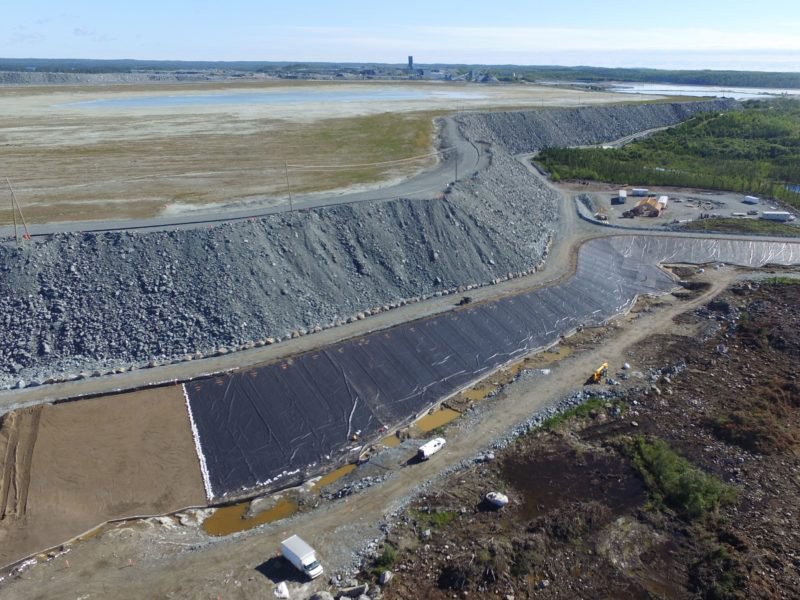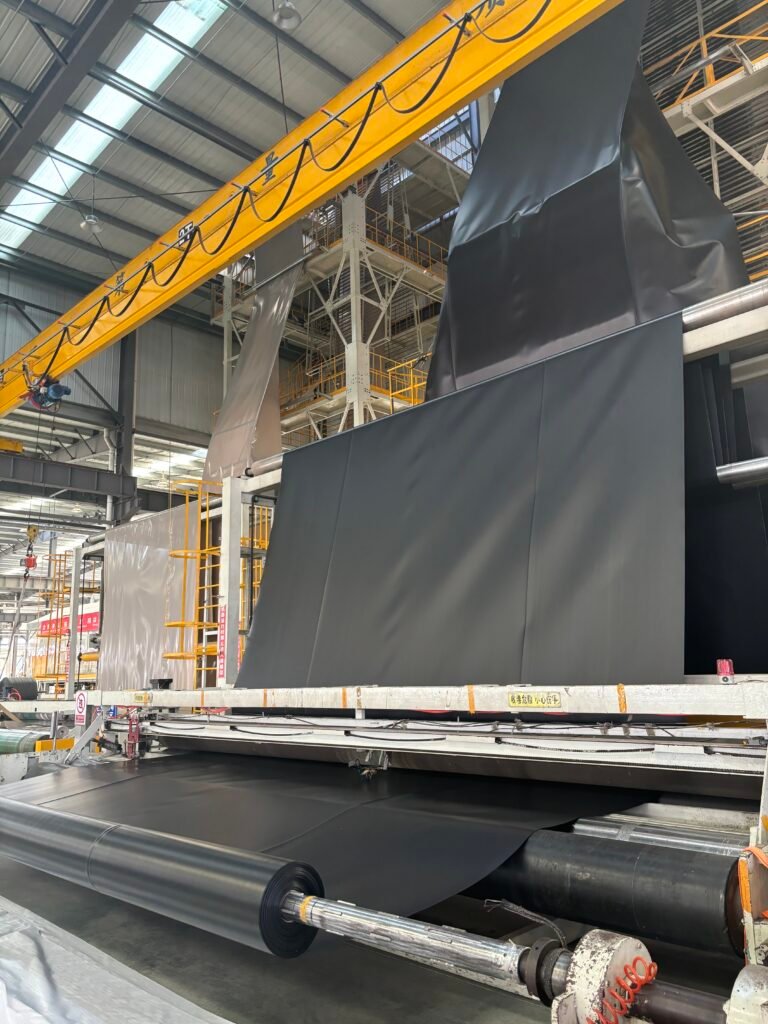Over the past decade, HDPE liner, also known as HDPE geomembrane liner, has become increasingly popular in the mining industry. Our BPM brand geomembranes have been installed in various mining projects around the world. With 20 years of experience in geotechnical engineering, we provide customers with high-quality products and professional mining installation experience.
High-Density Polyethylene (HDPE) liners have become the gold standard for containment solutions in mining operations worldwide. These impermeable geomembranes provide critical environmental protection while offering superior performance in challenging mining conditions. From heap leach pads to tailings storage facilities, HDPE liners serve as reliable barriers against contaminant migration.
Next, BPM Geosynthetics (BPM Geomembrane) will discuss the following aspects of HDPE Liner as the Benefits for mining projects.

1. What is HDPE Liner?
As we all know, HDPE liner is the most commonly used waterproof material. It uses polyethylene virgin resin as raw material, adds carbon black, anti-aging agent and anti-ultraviolet absorber, etc. It is produced by three-layer co-extrusion blow molding process or calendering process technology using geomembrane equipment. HDPE liner is often used in aquaculture projects, garden projects, salt ponds and mining projects. Especially in mining washing ponds, heap leaching fields, dissolution ponds, sedimentation ponds and tailings low-sinking and anti-seepage projects.

2. What Are Key Features of HDPE Liner?
2.1 Exceptional Chemical Resistance for Harsh Mining Environments
In the geotechnical material market, there are many materials for geomembranes, such as HDPE materials, LDPE materials, LLdpe materials, PVC materials, EPDM materials and so on.
2.2 Why Chemical Resistance Matters in Mining
Mining operations involve contact with highly corrosive substances including:
(1)Sulfuric acid in copper leaching
(2)Cyanide solutions in gold extraction
(3)Heavy metal-laden process water
(4)Hydrocarbon byproducts
Traditional materials like clay or concrete often degrade when exposed to these aggressive chemicals, leading to containment failures.
2.3 HDPE’s Superior Chemical Performance
2.3.1 HDPE liners demonstrate remarkable resistance to:
(1)Wide pH range (acidic and alkaline solutions)
(2)Organic solvents and hydrocarbons
(3)Oxidizing agents
(4)Saline environments
2.3.2 Laboratory testing shows HDPE maintains its structural integrity even after prolonged exposure to:
(1)98% sulfuric acid
(2)50% sodium hydroxide
(3)Various metal ion solutions
Case Study: Heap Leach Pad Performance
BPM Chilean copper mine reported zero liner degradation after 5 years of continuous exposure to pH 1.5 leach solutions, demonstrating HDPE’s unmatched chemical durability.
3. HDPE liner – Superior Impermeability for Environmental Protection
3.1The Science Behind HDPE’s Impermeability
HDPE liners boast:
(1)Hydraulic conductivity <1×10⁻¹³ cm/sec
(2)Water vapor transmission <0.3 g/m²/day
(3)Molecular density that prevents fluid migration
Comparison with Alternative Materials
Material | Permeability (cm/sec) | Mining Suitability |
HDPE | <1×10⁻¹³ | Excellent |
PVC | 1×10⁻¹⁰ | Good |
Clay | 1×10⁻⁷ | Poor |
Concrete | 1×10⁻⁶ | Unsuitable |
4. HDPE liner – Unmatched Durability and Long Service Life
4.1 Physical Properties Ensuring Longevity
(1)Tensile strength: 25-35 MPa
(2)Puncture resistance: 400-800 N
(3)Tear resistance: 150-300 N
4.2 UV and Weather Resistance
Properly formulated HDPE liners with:
(1)2-3% carbon black content
(2)UV stabilizers (HALS)
Can withstand:
(3)Continuous UV exposure
(4)Temperature extremes (-60°C to +80°C)
(5)Freeze-thaw cycles
4.3. Field Performance Data
Installation | Years in Service | Condition |
Australian Gold Mine Tailings | 15 | Minimal degradation |
Canadian Oil Sands Pond | 12 | Fully functional |
Zambian Copper Leach Pad | 10 | No leaks detected |

5. HDPE liner – Cost-Effectiveness Over Project Lifecycle
5.1 Initial Cost vs. Long-Term Value
While HDPE may have higher upfront costs than alternatives, its lifecycle benefits include:
(1)50-100 year service potential
(2)Minimal maintenance requirements
(3)Elimination of remediation costs
6. HDPE liner – What properties does mining geomembrane need to have?
6.1 Chemical resistance
Chemicals present in mining environments (kerosene, diesel, acid, naphtha, jet fuel, brine, crude oil and gasoline.), we need to choose HDPE membrane materials that can withstand exposure to these substances. HDPE geomembranes have excellent chemical corrosion resistance, which can ensure that we will not degrade or damage due to exposure to these chemicals. Mining geomembranes help to control salt water in evaporation ponds, increase salt collection rates and reduce precipitation. Our mining geomembrane liners can resist chemical corrosion from high concentrations of salt for a long time, have very low permeability, and have strong UV resistance.
6.2 UV resistance
If your mining project involves outdoor applications, choose HDPE membrane materials that are UV-resistant. This feature prevents degradation caused by prolonged exposure to sunlight.
6.3 Anti-seepage performance
Mining geomembranes are exposed to the elements and must both protect the environment and prevent solution loss so your precious metals and profits are not washed away. Evaluate the ideal level of impermeability required for your mining application. Geomembrana HDPE is typically low permeable, but it is important to ensure it meets specific permeability requirements to prevent fluid migration and protect the environment.
6.4 Thickness
For mining projects, the minimum thickness of geomembrane is 1.5mm, and geotextile should be used for protection. We generally consider that mining projects need to have tensile strength and elongation, as well as puncture resistance and tear resistance. Customers need to choose 2mm HDPE geomembrane. Because the technical indicators of 2mm geomembrane are higher than those of 1.5mm geomembrane.
7 HDPE liner – GM13 100% virgin material standard
In mining projects, due to the large number of chemical substances, high environmental acid and alkali resistance quality indicators are required. Engineering projects generally require suppliers to meet the GM13 standard. And have any specific mining industry certification. The geomembranes produced by our BPM have passed the TRI and SGS testing agencies. At the same time, we are also a member of the IGS geotechnical materials industry.

8. Conclusion
As a leading HDPE geomembrane manufacturer with 20 years of experience, our factory operates three lines for smooth HDPE geomembranes and one for rough surfaces. We produce HDPE geomembranes ranging in width from 2 meters to 10 meters and thicknesses from 0.2mm to 3mm. Since our products are shipped in containers, most customers request widths of 5.8m, 7m, or 8m. However, we can accommodate other widths as well. Please note that producing a 3-meter wide geomembrane may result in some raw material waste, which could make it more expensive than the standard widths (5.8m to 10m).




